MVW Vs VAS – What Is The Best Australian ETF?
Last Updated on 20 February 2024 by Ryan Oldnall
Australia has a growing number of ASX Exchange Traded Funds (ETFs) available with over 200 now in existence. This growth has provided investors with greater choice and variety when it comes to their investment possibilities.
ETFs are an excellent means of diversification as they encompass various securities like stocks, bonds, and commodities. The strategies of MVW Vs VAS are very different which we will explore in this article.
This diversification effectively reduces the overall risk in contrast to investing solely in individual stocks.
By investing in a single ETF, you can gain exposure to a diverse array of assets or sectors, thereby spreading your risk across numerous holdings, potentially numbering in the dozens and even hundreds.
ASX Tracking Exchange Traded Funds (ETFs)
A number of different ETFs seek to replicate the performance of the ASX. These include Vanguard Australian Shares Index ETF (VAS), iShares Core S&P/ASX 200 ETF (IOZ), and Betashares Australia 200 ETF (A200).
These ETFs aim to replicate the performance of either the ASX 200 or ASX 300, which represent the 200 and 300 largest companies listed on the ASX, respectively.
The portfolio allocation of these ETFs is determined by the market capitalization of the companies included. Consequently, larger companies hold a more significant proportion within each ETF. For instance, in the case of the Vanguard Australian Shares Index ETF (VAS), BHP Group (BHP) represents 9.88% of the portfolio.
Equal Weighting ASX ETF
The Equal Weighting ASX ETF follows a simple principle – it allocates an equal weight to each of its holdings. An example of such an ETF is the VanEck Vectors Australian Equal Weight ETF (MVW), which evenly distributes its investments across all 80 holdings in its portfolio (at time of writing). Therefore, in theory, each holding represents approximately 1.25% of the total value of the ETF.
This approach contrasts with traditional ETFs like VAS, where the allocation of assets is based on market capitalization. For instance, the BHP holding in MVW would account for only 1.25% of the total ETF value, while in VAS, it has a much larger allocation at around 9.88%.
Due to this significant difference in asset allocation, MVW does not track the performance of the ASX 200/300 index as VAS does.
MVW Vs VAS – How Do They Compare

Although MVW and VAS do not track the same index, which prevents a direct like-for-like comparison, we can still assess their total performances over the last five years.
YTD Total Growth Comparison Since the market opened in 2018, MVW has achieved a 13.4% higher growth rate than VAS.
Downside of Equal Weighted ETFs
Although the numbers seem to favor MVW over VAS, there are other factors to consider. The equal weighting approach employed by MVW has both advantages and disadvantages. As a stock’s value increases, its weight within the ETF also increases. Conversely, when a stock performs poorly, its relative weighting decreases.
Due to the equal weighting strategy, MVW undergoes quarterly rebalancing. This process involves selling off the higher-performing stocks and purchasing the under-performers to restore the equal weighting. However, this rebalancing can lead to additional costs in the form of capital gains taxes.
When a stock is sold, any profits or losses from the sale become realized, requiring payment of capital gains taxes and potentially reducing overall profits.
Furthermore, the consistent rebalancing required by MVW results in management costs that are five times higher than those of VAS. In a $10,000 portfolio, VAS charges $7 in management fees, while MVW charges $35.
Therefore, when scaling the portfolio up tenfold, the cost difference becomes considerably wider. These factors should all be taken into consideration when selecting an ETF which seeks to mirror the performance of Australian shares and the wider Index.
What Is The Best Australian ETF? See the comparison of Australia’s largest ETF, Vanguard’s, VAS with the equal-weighted ETF powerhouse Vaneck’s, MVW
This article is for informational purposes only and does not constitute as an endorsement or recommendation to purchase any specific mentioned product.









